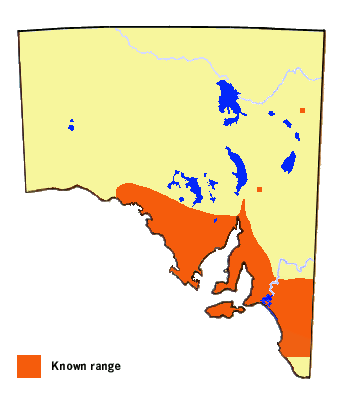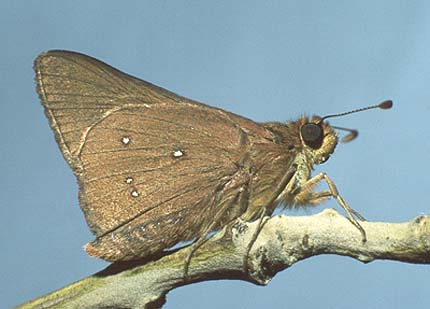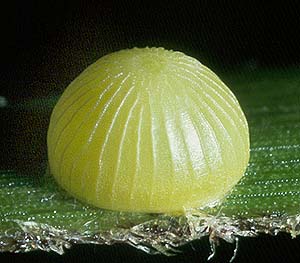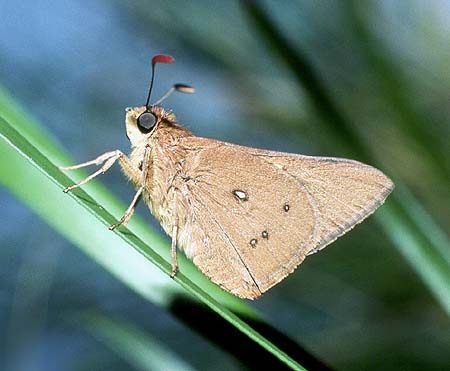-
Larval Food Host
-
Lepidosperma carphoides (black rapier-sedge),
L. concavum (spreading sword-sedge), L. viscidum (sticky sword-sedge),
Schoenus spp (bog-rushes) (Cyperaceae).
The larvae use L. carphoides in sand based soils, particularly dune areas,
and L. viscidum in areas with heavy soils or in rocky hills. The latter
sedge has narrow, erect strap-like stems and leaves, while the former has wiry
stems and leaves and grows like tussock grass. (L. carphoides is readily
distinguished in the field from other wire-leaf sedges by having small, black
coloured, single flower heads shaped like a flying bird.) The female has an egg
laying preference for young or small plants. L. viscidum is the preferred
hostplant. The skipper is not known to use L. concavum in South Australia,
even though it is a common sedge growing in soils that are sand based. The larvae
eat the leaves of the hostplants. Its hostplants in the Far Northeast are unknown.
-
Eggs
-
Very large 2.0 mm (along the long axis), pale yellow, hemi-ellipsoid (but nearly hemispherical),
base flat, with numerous very indistinct vertical ribs, numbering about 29-35, and laid singly
on the hostplant. The eggs do not acquire red markings if fertile. The small micropylar area
on top of the egg is depressed. Eggs are usually laid on hostplant situated in full sun, and
are only laid on living, green leaves of the hostplant. Larva development within the egg
commences immediately after being laid, and larvae begin to emerge after about 23 days in
spring. The egg shell is eaten by the larva after its emergence.
-
Larvae
-
The first instar is long cylindrical, initially pale yellow but gradually turning
yellowish green after eating the hostplant, the anterior and posterior ends are
dark pink, and the head is black, large shining, slightly rugose, having a few
long hairs, the prothoracic plate is black but the surrounding neck area is dark
wine red coloured, and long recurved hairs occur posteriorly. After eating the
egg shell, the young larva moves off to the congested lower parts of the hostplant
and makes a small shelter by either silking together several leaves of the hostplant
or by making a loose webbed shelter against a larger leaf. The young larva rests in
the shelter during the day with its head pointing either upwards or downwards.
It eats at night by feeding on the outer parts of the leaves. The shelters are open
ended initially, but in later shelters the basal part is sealed.
Subsequent instars gradually lose the long posterior hairs, but retain a similar body
colour throughout their life. New shelters are periodically constructed to fit the
growing larvae, using the leaves of the hostplant if the hostplant is dense enough, and
the internal diameter of the shelters is approximately the diameter of the larvae.
With L. viscidum the shelters are nearly always at the base within the congested
area of leaf growth, and are rather simple. Intermediate instars make a loose webbed
shelter on the sides of the leaf bases, but the final shelter is usually deep within the
leaf bases. However, most of the egg laying by the females is done on very small
plants, which cannot support shelters of the mature larvae and the latter have to build
shelters in leaf debris or similar material on the ground near the hostplants.
With L. carphoides the shelters are usually made in the outer parts of the sedge
and are more elaborate, utilising many wiry leaves to construct a straight or slightly
twisted elongated tubular structure 7-10 cm long that opens at the top, and which is
strongly lined with silk internally. Larvae continue to rest and hide from predators
within the shelters during the day with their heads directed upwards, and emerge to eat
briefly at dusk (usually) or late at night, eating leaves from anywhere on the plant.
They eat the L. viscidum leaves by eating from the leaf edge inwards towards the
centre of the leaf (without eating through to the other edge) while they remain positioned
on the basal part of the uneaten edge of the leaf, leaving a characteristic sharp,
straight eat mark on the leaf. The start eating from near the tip of the leaf, and
work their way back down towards the leaf base, and usually continue to eat from the
single leaf blade until they reach fourth instar stage. (Larvae of most other
species of skippers eat while stationery on the already eaten portion of the leaf.)
They grow slowly, and pupation occurs in the final shelter during late winter or early
spring.
The final instar is long cylindrical shaped, about 35 mm long, with the last posterior
segment flattened into the anal plate, smooth, but with the posterior end having some
hairs. The head is large, rugose, elongate, there is a slight central longitudinal furrow,
the top is rounded, with a few long mouth hairs, and some obvious short white setae on the
front that are flattened club shaped with a blunt point. The body is semi-translucent
yellowish green, being more yellowish anteriorly and posteriorly, there is an indistinct
darker longitudinal dorsal line, the anterior and posterior ends are dark
pink, and the neck is red. The head and mouthparts are black or dark brownish
black. The body, and particularly the anal plate on the last segment, have some tiny
secondary setae. Along the body they are wine glass shaped set on transparent simple
raised bases. On the anal and prothoracic plates they are a deformed wine-glass
shape (one edge longer than the other) and are slightly flattened, and some of which are
set on brown coloured raised bases.
The presence of larvae on or near the hostplant is discernible by either, the
characteristic eat marks on the broadleaf hostplant Lepisosperma viscidum, or in
the case of the wireleaf Lepidosperma carphoides by a large shelter in its outer
parts and a number of chewed-off leaves near the shelter.
-
Pupae
-
Long cylindrical, about 22-24 mm long, dark brown and pale yellowish brown,
with the abdominal area being pale yellowish brown, and with brown posteriorly
directed abdominal bristles, which arise from depressed bases. The posterior end
tapers to a short, rounded or squared, dark brown cremaster, having brown coloured,
long, posteriorly directed bristles. The head is rounded, with the head cap (operculum)
being black, having a characteristic rounded shape, and there are some short hairs.
The central part of the operculum is heavily sclerotised (very rugose) and is divided into
three equal sized, oval shaped segments, a single ventral part, and two dorsal parts that
are elevated (in profile) above the ventral part.
Pupation occurs in the final larval shelter, and the larva pupates with its head
directed upwards. The pupal duration is about 36-42 days in spring. The empty
pupa case remains inside the shelter after the adult skipper emerges, and is dark brown
coloured.
-
Flight Period in South Australia
-
The skipper is single brooded in southern temperate areas and has a short flight
in spring lasting about one month in any single locality. The flight commences
earlier in the northern temperate areas. The skipper overwinters as larvae.
In the Far Northeast of the state it has been recorded as flying in April.

-
Distribution
-
The skipper usually occurs wherever its principal hostplants grow in a high enough
density, and that includes most of the southern agricultural belt, and also Kangaroo
Island. In the northern Flinders Ranges it normally occurs on the high plateaus
where it's known hostplants survive. In the Far Northeast where a single female has
been recorded from the Strzelecki Creek it is not known if the skipper is a permanent
resident in this area or whether it has taken advantage of a moist season and temporarily
expanded its range from the northern Flinders Ranges along the ephemeral creek systems,
or whether it is an accidental transport. It has yet to be found in the high rainfall
areas of the Lower Southeast Region, and although most of the suitable heavy soil
habitat in this area has now been cleared, there are still sandy soil areas containing
L. carphoides. This subspecies of the skipper is also known to occur in western
Victoria. Other subspecies occur in NSW and southwest WA.

-
Habitat
-
The skipper requires broad acre pristine habitat, where it will occur wherever
its principal hostplants are growing, and that includes heavy soil and rocky hill
areas for Lepidosperma viscidum, and sand based soils for L. carphoides.
These habitats include mallee and open woodland areas. Males are very active hilltoppers
and prefer habitat containing elevated areas, although it is not a habitat prerequisite.
Much of its preferred habitat has now been fragmented due to agricultural and urban
development. In the Far Northeast its habitat is probably the ephemeral desert
waterholes of the Strzelecki Creek. The surrounding desert consists of dune fields.
-
Conservation Status in South Australia
-
The skipper is widespread in distribution. It is very rarely seen in flight
in the moist woodlands of the southern parts of the agricultural belt,
but is still maintaining a locally common status in the pristine mallee
remnants either within the large mallee dominated conservation parks of
the Upper Southeast and Southern Eyre Peninsula Regions, in northern
rocky hill areas of northern Eyre Peninsula, or in the southwest part
of Kangaroo Island, and collectively on that basis is considered to be local.
-
Threats
-
The main threats are from bushfires, and the effects of agricultural and urban disturbances.
Much of its preferred habitat is now fragmented and the skipper has been unable to recolonise
many of these areas after bushfires or degradation. Habitat adjacent to farming areas is
susceptible to toxic spray drift, especially when it is applied by aerial means.
-
Conservation Strategy
-
The skipper requires broad acre pristine habitat for survival, but so long as
there is no further degradation or clearing of remnant vegetation in its
distributional areas its populations should remain stable.




